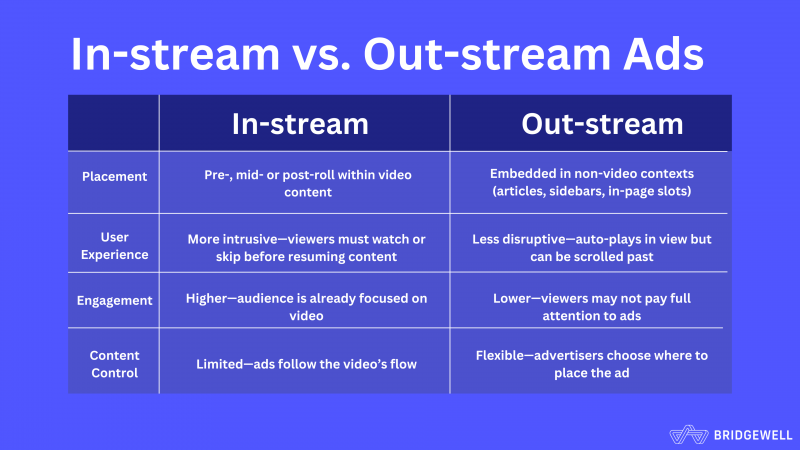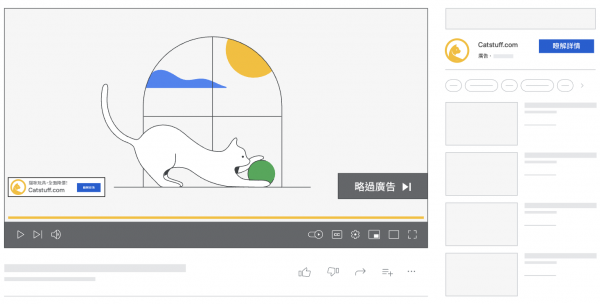In-stream ads—pre-, mid-, and post-roll—offer high visibility and engagement by inserting ads directly within video content, making them one of the most effective formats in video advertising.
In-Stream vs. Out-Stream Video Advertising Guide
Pre-roll、Mid-roll、Post-roll are all common In-stream ad formats. Compared to Out-stream video ads, In-stream ads are usually embedded in video content or before video playback, and are considered more native. In this article, we’ll break down the differences between the two formats and explain which types of ad placements better align with your brand strategy.
A Quick Guide to In-Stream Video Advertising
In-stream ads typically include pre-roll, mid-roll, and post-roll formats. These ads are usually inserted in online video platforms, live broadcasts, or OTT streaming media, playing either before, during, or after the video content. This type of ad has high exposure and strong user attention, making it one of the most effective formats in video advertising.

–
What is a Pre-roll Ad?
Pre-roll ads are the most common type of in-stream video ads. These ads play automatically before the main video content, usually lasting 5 to 30 seconds. Pre-roll ads are widely used on YouTube, video-on-demand (VOD) services, and OTT platforms such as smart TVs.
How Do Pre-roll Ads Work?
When a viewer clicks on a video or enters a video page, pre-roll ads are triggered before the main content plays. Advertisers only have a few seconds to grab the viewer’s attention and deliver a key message, so creative strategy is critical.
Some pre-roll ads are skippable after a few seconds, while others must be viewed in full. Advertisers can also choose to target specific devices or platforms based on their audience’s viewing behavior.
The Pros of Pre-roll Ads
-
High visibility: These ads appear before the main content, ensuring that viewers are paying attention.
-
Flexible creative formats: Brands can tailor messaging to fit time constraints and use storytelling or CTA elements.
-
Strong targeting capabilities: Using audience data and retargeting, pre-roll ads can be highly personalized and effective.
-
Supports brand recall: Studies have shown that pre-roll ads help boost brand awareness and message retention.
Common Use Cases for Pre-roll Ads
-
Product launches: When a new product drops, pre-roll ads can quickly generate buzz and reach early adopters.
-
Brand campaigns: Ideal for large-scale branding efforts that prioritize high visibility.
-
Event promotions: Whether it’s a concert or a live stream, pre-roll ads get the word out at the right moment.
-
Cross-platform marketing: Pre-roll ads are great for bridging desktop, mobile, and OTT audiences.
Types of Pre-roll Ads
Pre-roll ads come in a variety of formats. Depending on your campaign goals and media plan, you can choose from the following:
Skippable Ads
Skippable pre-roll ads allow viewers to skip the ad after a few seconds. They’re ideal for awareness campaigns where the viewer has control over whether to continue watching. While skip rates may be high, these ads still boost reach and brand recognition.

–
Non-Skippable Ads
Non-skippable pre-roll ads require the viewer to watch the entire video before accessing the content. These are great for short, impactful messages. They’re particularly effective for product announcements or limited-time offers.
Bumper Ads
Bumper ads are short, non-skippable video ads (usually 6 seconds) designed to deliver a quick, memorable message. They’re ideal for high-frequency brand campaigns and work well on mobile devices.
Other In-Stream Ad Formats
Mid-roll Ads
These ads appear in the middle of video content. Because they interrupt viewing, mid-rolls typically require longer content to work well (think livestreams or full episodes). They’re best for mid-to-late funnel targeting or reinforcing brand messages.
Post-roll Ads
Post-rolls play after the main video content ends. Viewers are less attentive at this point, but they may still be effective for delivering follow-up messaging or driving next steps (like app installs or product demos).
